As an Amazon Associate I earn from qualifying purchases.
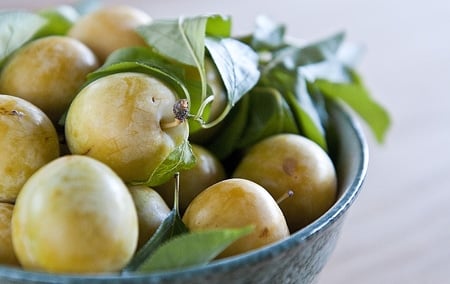
I see wild plums. They’re everywhere. And people don’t know they’re plums.
Even me. When we moved to California, I began seeing these odd red trees — the whole tree is a deep burgundy red. Weird. No one seemed to know what they were called. One of these trees grows two doors down from me in a neighbor’s front yard. Walking to the gym in summer, I’d notice it would be festooned with scores of what, to all the world, looked like cherries.
No one ate them. Could they be bitter? Poisonous, even? Finally, last year at around this time, I screwed up my courage and ate one. Wow. Tart, sweet, and definitely not poisonous or bitter! These little things tasted like a cross between a cherry and a plum.
I looked them up: Sure enough, the trees, which are planted literally everywhere around here, are prunus cerasifera, commonly known as the red-leafed or cherry plum.
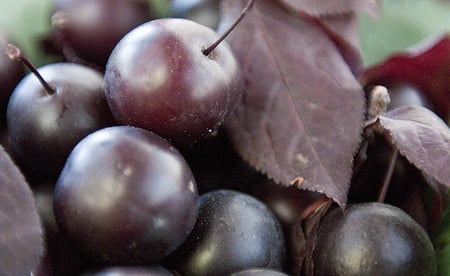
Now that I know what they are I see them on every block, in nearly every shopping center, especially in the nearby town of Rancho Cordova, where there must be some ordinance promoting the planting of plums.
Thus the conundrum: Almost all of them are on private property. My first foray for cherry-plums was in my neighborhood park, which has several trees dotted around it. Unfortunately, either this was an off year for the park trees or someone had picked them before me. All I got was a small produce bag of them, which Holly and I ate without further ado.
I resolved to scope out more trees I could pillage when the owners were not looking. Maybe on a Sunday morning?
Meanwhile, while I was on one of my foraging walks in the area I caught a glimpse of something in the corner of my eye. It was a large, light-colored orb in a tree. My first thought was oak galls, which are all over the blue oaks around here. I stopped and looked. Wait a second. This was no oak tree, and those were not galls…
They were plums! Wild plums! And the tree is loaded with them. These are the plums you see at the top of this post. How this tree got here is a mystery to me. I cannot find references to wild plums living in our part of California; another type of wild plum, a red one, lives up north near Klamath. Maybe it is feral? Maybe it’s just rare? My friend Elise knows of another such plum near American River College, so it’s not unique.
These plums are very different from the neglected cherry-plums in suburbia. The wildlings tasted, well, wilder. More tannic, coated in a pretty bloom like a white wine grape. Tart like the cherry plums, but not as sugary. My kind of fruit.
And they are all mine. No one else knows about this tree. It is off the beaten path, and even though the tree is loaded and the fruit is ripe, not a one had been picked, at least visibly. It is my secret treasure…
Back to the cherry-plums. Last week Holly, our friend Evan and I went for a quick barnyard pigeon and cottontail rabbit shoot out at his ranch — my first hunt since my injury in December — and, after we dispatched a brace of cottontails and a trio of barn pigeons, headed to a local diner for dinner.
Holly parked right next to a cherry-plum tree. A small one, too. As I got out of the truck, I looked into the tree out of habit. It was loaded. I mean groaning under the weight of so many plums! “We have to pick these,” I told Holly, who was game for it. So after dinner, we furtively filled up a grocery bag fill and headed home with our booty.
We ate a few plums on our way home. God, are they good! So tart and sweet.
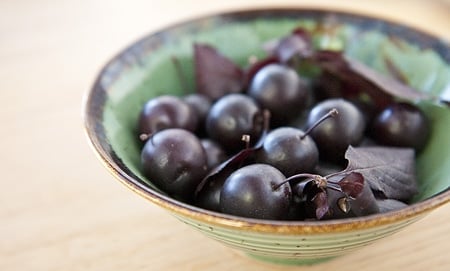
Now I had enough to do something with them. I immediately thought plum liqueur, and I have a Mason jar full soaking in vodka right now. What else?
Well, I always make ice creams and syrups. I wanted to do something different this time. What about a pie? A pie? But Hank, you never bake pies. Ever. This is true. Here’s an admission: I’d never made a pie from scratch before. Really. I’ve made wild boar liver creme caramel, lemon verbena panna cotta, oddball cakes and weird sorbets, but never a simple pie.
I don’t eat pie very often. I do like a slice of apple pie with a hunk of cheddar cheese on it (meaning I am a true New England Yankee at heart, I guess), cheesecake, which is really more of a pie, as well as Holly’s mother’s pecan pie, which is to die for. But that’s about it.
Then I watched a recent episode of Top Chef, where the contestants were required to bake a pie. Any pie. One contestant said to the judge that she hoped she didn’t screw things up too bad, considering she wasn’t a pastry chef. The judge replied, “That’s a cop out — my grandmother isn’t a pastry chef and she can bake a pie.” Ouch. Point well taken.
Not that I am planning on going on Top Chef anytime soon, but it suddenly seemed that I oughta be able to make a pie. Good thing Elise is a well-known pie maker. So I schlepped the cherry-plums to her house and she taught me how to make a plum pie.

The pie crust is all Elise, but the filling is all mine. The trick to a pie filling, it seems, is to get it to set up once the pie has cooled; we cut into mine a little early, and the filling oozed over everything. No bueno. Crossing our fingers, I put the pie in the fridge overnight before cutting another slice. Success! The six tablespoons of flour in the filling did the trick.
I also tossed in some chopped walnuts — I’d wanted to use black walnuts, another native tree in the area, but couldn’t find them — as well as an odd ingredient: sage. Yes, sage. It goes well with plums, and I wanted a taste of wildness in the filling. I could barely detect it, but I’d like to think I’d notice if the sage were not in there. At last that’s my story…
So there it is: I’ve made my first pie. What do you think?
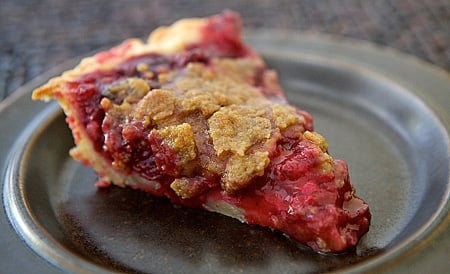
Now I know, you are thinking, what about that loaded wild plum tree? You making pie with that, too? Oh no, dear reader. I have a far more special purpose in mind for these plums.
Remember I said they were acidic, only mildly sweet, and a little tannic? What does that make you think of? If you guessed wine, you guessed correctly. So I am making a three-gallon batch of wild plum wine.
I’m letting the wild plums ripen a little longer, and plan to boost the sugar levels with some local honey to bring the alcohol level up to that of a normal table wine. I have high hopes for this wine; one of the finest wines I’ve ever made — and I make “real” wines now, with real wine grapes — was a burly red I made from damson plums. If I could find some here in California I’d make it again.
But this wine will be different. It will be a white. Crisp, dry, floral. Like I said, I have high hopes for these plums. But it’ll be a while before I can report on the results: Like all wines, it’ll take close to a year before I pull my first cork. Let’s hope it’s worth the wait.

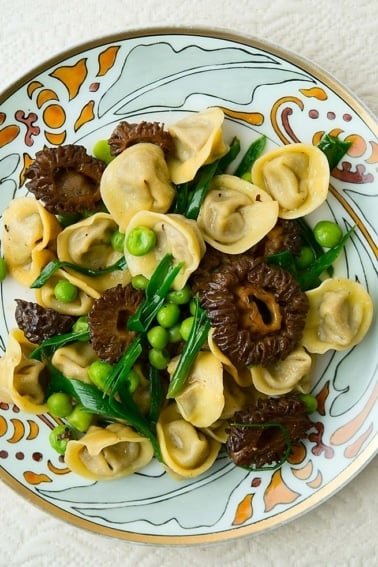
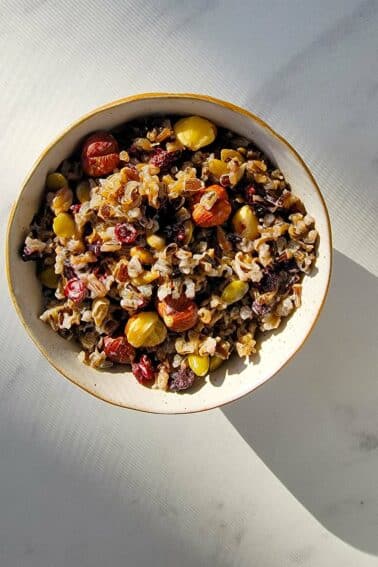
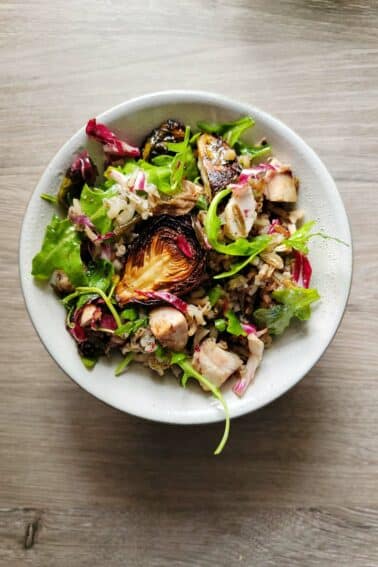
How fun to find those plums. And, plum liqueur sounds tempting! Might have to try that.
Thanks for mentioning the black walnuts. I had forgotten about those. My Dad grew up in Marysville, so we used to go up north almost every summer for family vacations. I remember all the walnut trees we’d see, and I have fond memories of eating black walnut ice cream at my grandparents. Since I was a little kid, I didn’t really know why they called them “black” walnuts. I just assumed they were burnt or something so i used to spit them out. LOL Only when I got a bit older did I actually eat them.
How delicious looking. I’ve never seen the little red cherry-plums, but we do have “wild” (or perhaps escaped cultivated) plums down in S. Georgia. As children, we’d raid the trees, but our favorites were not the ripe and sweet fruits. We’d pass those over for the crunchy green ones. We’d dip them in salt to cut the tartness and bitterness and happily munched away. In fact, whenever I see these little plums being offered at our local farmer’s market, it’s always a bin of the unripened, green fruits that are for sale.
I have never heard of eating unripe plums with salt, but it sounds pretty cool! Sort of like a green papaya or mango salad, which is more savory tart than sweet. ~Hank
When I hung pest detection traps for the county, purple plum trees (as we called ’em) were very helpful, because they tended to have nice, over-ripe fruit on them – perfect for calling in any stray medflies that might be about.
The riper, the better for me!
As for the Food Network commentary, I’m willing to bet that many grandmothers can out-pie many pastry chefs!
Sigh. Now that Hank has discovered pie, we’re going to have to eat more chickling vetch beans to keep the ole padunkadunk in balance.
Glad to hear you’re making wine from them!!! I like pie, but I’d far rather drink a few bottles than eat a gazillion pies.
If it hangs over the pavement (english for sidewalk) I’m coming back with a step ladder.
SBW
We’ve got one of the fruit-bearing cherry plums growing on our parking strip. Ever since I learned it was a plum and not an ornamental cherry of some kind, I’ve been toying with doing battle with the crows over its fruit. Hank, your description of the flavors may have been the last bit of incentive I needed 🙂
Unfortunately, or fortunately, depending on what your preference is — breeders have learned how to take the “plum” out of the red-cherry plum trees. The newer trees that you see planted all over suburbia are the “plum-less” version — although the trees do retain that darkish, purple-red leaf color. You won’t find any plums there, however. I had access to a producing tree many moons ago while growing up in Motown and used to “help myself” quite often. Good plum indeed!
Not all of them! Although you are right, I do see plum trees that have been de-plummed. Sad. Like a declawed cat. ~Hank
Yay Hank! A pie virgin no more. Pie is great food. Yours is so lovely and colorful! I hope you make many more and that your wine turns out well too. Of course, you could also try to make slivovitz, the Slovak cure-all for what ails ya.
I love these plums! I have 2 tress to pluck from. I make a Plum B.B.Q. sauce with them that I can make really spicy or sweet and tangy. My family and friends ask for it every year.
Plum BBQ sauce is a great idea! Will have to try that one. ~Hank
I grew up with these – one of the few foods we foraged.
They were planted as decorative trees along the roads (and known simply as ornamental plums), and as children we would spend a lot of time climbing trees and picking plums on our way home from school…of course, this was invariably in the spring, and with the later growing season in Canada we ate them rock-hard and sour.
My great-grandmother had a yellow plum in her backyard in Benicia many, many years ago. It had come up wild just inside her back fence. They were loaded with flavor, but not very sweet at all. She made wine from them and mixed them with figs in a preserve.
First off — love the website! I would call you a kindred spirit, but we don’t know eachother that well.
On the yellow plums: on sections of Vancouver Island and around Vancouver B.C., there are piles of them growing wild. I’ve been advised that they are Chinese plums by my dad, who’s a fan of fruit trees; apparently he ate tons of them growing up.
Which would make me think that these trees could be found in areas that have a historically high amount of Chinese (like the Lower Mainland, California, and Vancouver Island). As an aside, I think it would be worthwhile to track down old railway lines, because on Vancouver Island most wild fruit trees including these plums grow along rail lines as the leftovers of meals that got tossed from the windows. There are some neat old varieties mixed in: I once found an apple tree that had pink marbled flesh and tasted like rosewater.
Looking forward to the wine reports.
Thank you. These trees are all over my neighborhood. Mostly along the curb, fruit all over the sidewalk. I was out walking with my mother and she said they were decorative and not edible. But they looked so good. I am just not as brave as you are as to go and eat one.
Now that I know I might take a bag with me when I walk the dog and harvest what I can.
Pretty work on the pie…glad to see you take the plunge and make some proper summer time sweets! The anise flavor of black walnuts pairs nicely with plum…my grandmother would make a topping out of black walnuts for a lot of her plum and berry cobblers/crisps.
Great post, Hank! We make a kick-butt wild plum mead at our house, but learned the hard way about the high pectin content of wild plums. We have to be very careful to keep temp below boiling point, and be willing to use pectic enzyme to ensure clarity. Good luck!
These are extremely common around San Francisco, and in fact we have two in front of our house. However, they don’t tend to fruit very well here. We’re definitely getting some dropped fruit now, though, so perhaps I’ll pull out the ladder and do some harvesting before it’s too late.
Our neighbor has one of these trees and for the longest time I just thought it was a cherry tree. This season I may have to ask for some to mix in with my rhubarb and make sauce!
I always wondered about those plums. Thanks for the info.
There is nothing quite like scrumping from your neighbors yard! I am now totally going to look around and see if any neighbors here have them. I figure they should grow up here too